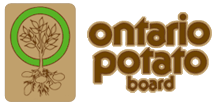How Potatoes Grow
 Potatoes are perennial plants planted in the spring and harvested in the fall. Potatoes grow underground on a special stem called a ‘stolon’.
Potatoes are perennial plants planted in the spring and harvested in the fall. Potatoes grow underground on a special stem called a ‘stolon’.
The potato stems above ground have attractive but non-edible flowers. Since the ‘root’ of the potato plant is not really a root but a stem, potatoes are also considered tubers.
Large potato crops are not planted with seedlings each year, instead, what is planted into the ground are ‘seed potatoes’ (potatoes that have hardened roots growing from them). These seed potatoes are cut into the desired size and planted in fields by special machinery. Farmers prefer seed potatoes of the same size to maximize the amount of potatoes created in a field.
Two to six weeks after planting you will be able to see potato plants rising from the ground depending on climate, time of year and the location of the plants. A potato field needs to be kept hydrated at all times. Potatoes can survive drought but do not produce as many potatoes if they do survive. As the season progresses, farmers must ensure that the crop is obtaining enough food from the soil, therefore, farmers test the plants regularly to ensure this. When the food that is distributed in the beginning of the season runs out, farmers feed their crops using advanced machinery once again.
The harvesting season begins in July and runs through the fall. The harvesting machines used have a big responsibility - without bruising the potatoes, the machines need to dig the potatoes out of the ground and separate them from stems, dirt and rock, all without bruising the crop during the process. Potatoes can be stored for up to eleven months in temperature-controlled environments until they are ready for packaging and shipping.
Source: potatoes.com

